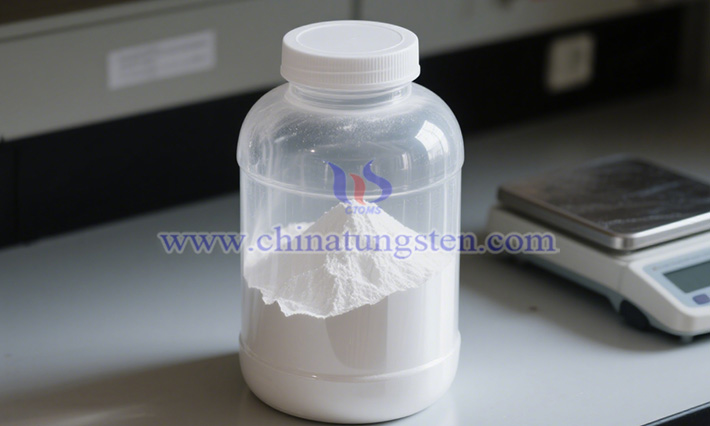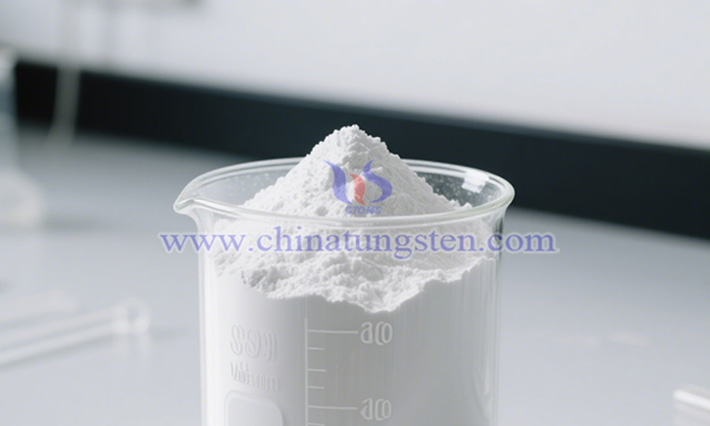Why Is Ammonium Metatungstate Solution Acidic?
- Details
- Category: Tungsten Information
- Published on Wednesday, 04 June 2025 14:52
Ammonium metatungstate (AMT) is a significant tungstate compound, typically represented by the chemical formula (NH₄)₆H₂W₁₂O₄₀·nH₂O (where n is the number of water molecules of crystallization, commonly 1 or 2). Structurally, it belongs to the polyoxometalate family known as "tungsten clusters." Its core structure consists of 12 tungsten-oxygen octahedra connected through shared oxygen atoms, forming a cyclic or cage-like framework, with ammonium ions and protonated water molecules filling the gaps.

The polytungstate anion [H₂W₁₂O₄₀]⁶⁻ forms through the polymerization of tungstic acid (H₂WO₄) under acidic conditions. When a sodium tungstate or ammonium tungstate solution is concentrated in an acidic environment, tungstate ions (WO₄²⁻) undergo stepwise dehydration and polymerization, eventually forming the stable dodecatungstate ion, which then combines with ammonium ions to produce AMT. The term "meta" in its name reflects an older chemical naming convention for polymeric oxyacid salts (e.g., metaphosphoric acid, metaboric acid), distinguishing it from simpler orthotungstates like ammonium orthotungstate ((NH₄)₂WO₄).
When dissolved in water, AMT fully dissociates into NH₄⁺ and [H₂W₁₂O₄₀]⁶⁻ ions, and its acidity is determined by the behavior of these ions in solution:

NH₄⁺, the conjugate acid of a weak base, undergoes hydrolysis in water, releasing H⁺ and making the solution acidic. Given the ionization constant of NH₃·H₂O as 1.8×10⁻⁵, the hydrolysis constant of NH₄⁺ is approximately 5.6×10⁻¹⁰. Although small, this hydrolysis still contributes a notable H⁺ concentration.
The polytungstate ion [H₂W₁₂O₄₀]⁶⁻ contains two dissociable protons (H⁺), behaving as a polyprotic weak acid with stepwise dissociation in water. Since polytungstic acid (the conjugate acid H₆[H₂W₁₂O₄₀]) readily dissociates in water, the dissociation of [H₂W₁₂O₄₀]⁶⁻ dominates over its hydrolysis, making the latter negligible.
In an AMT aqueous solution, H⁺ is produced both by NH₄⁺ hydrolysis and [H₂W₁₂O₄₀]⁶⁻ dissociation, resulting in a significantly higher H⁺ concentration than OH⁻, confirming the solution’s acidity. This is further supported by the fact that AMT synthesis requires acidic conditions, and the protons (H⁺) in its crystal structure are products of that acidic environment, readily dissociating in water. While polyoxometalates often exhibit "proton sponge" characteristics, the dissociation ability of the AMT anion framework in water surpasses the hydrolysis of NH₄⁺, making acidity the dominant trait.
- Chinatungsten Online: ammonium-metatungstate.com
- CTIA GROUP LTD: en.ctia.group
- Tungsten News & Price: www.ctia.com.cn
- Molybdenum News & Price: news.molybdenum.com.cn
- Tel.: 86 592 5129696; Email: sales@chinatungsten.com



 sales@chinatungsten.com
sales@chinatungsten.com